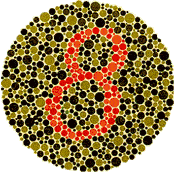A page from the "Causes of Color" exhibit...
How do doctors test for color vision deficiency?

Tests for color vision deficiency

|
Vision test examples.
People with typical color perception should see A=8, D=74. People with color deficiencies may see A=3, D=21.
In color perception tests, pseudo-isochromatic plates use printed dots of different chromaticity to produce patterns that can be identified as numbers, letters, or shapes. By choosing chromaticities that are confused by those with red-green dichromacy, patterns can be produced that are visible to trichromats (regular color vision), but invisible to dichromats, or that appear different to trichromats and dichromats. The first examples of such plates were those by Stilling (1st edition, 1875), but the more popular set of plates for color vision testing are those by Ishihara (1st edition, 1917).
Note the colors of your screen are probably different from those in calibrated test books. If you suspect that you are color deficient, we suggest that you have your color vision professionally evaluated.
How color vision testing works
This example shows how to develop a color vision test pattern for testing red-green deficiency (protanopes and deutanopes). In this example digits are used, but the principle can be applied to any pattern.
Step 1: Select a random pattern of gray level dots.
Step 2: Add a digit pattern (in this case 5) that is defined by yellow-blue variation only. This pattern can be perceived by any observer who is able to distinguish between yellow and blue. Since most people with red-green deficiency will be able to distinguish yellow from blue, they will be able to see the digit 5 in this test pattern.
Step 3: Select a digit pattern that is defined by red-green variation and is easier to see than the pattern defined by yellow-blue variation. The digit 6 was selected here. The image shown here is the pattern composed of the random brightness pattern (step 1) and the red-green pattern. Individuals with red-green deficiencies (protanopes and deutanopes) will only see a gray pattern here.
Step 4: Finally, add all three components: the random brightness pattern, the yellow-blue pattern, and the red-green pattern. Observers with red-green deficiency will not be able to see the red-green pattern and base their response only on the yellow-blue pattern. They will therefore see the digit 5. People with regular color perception will see both the yellow-blue and the red-green pattern. Since the red-green pattern is stronger than the yellow-blue pattern, the subject with normal color perception will base his or her judgment on the red-green pattern and see the digit 6. Observers with blue-yellow deficiency also see the digit 6.




